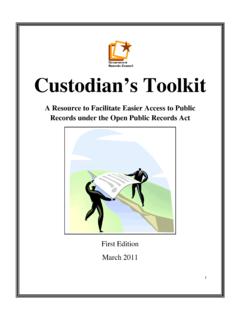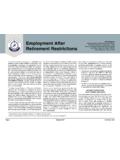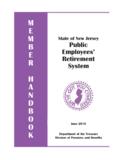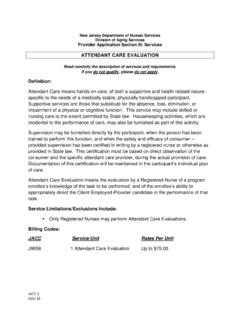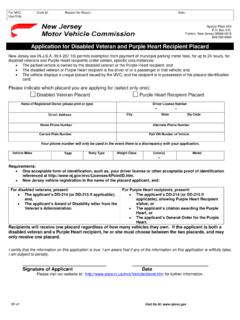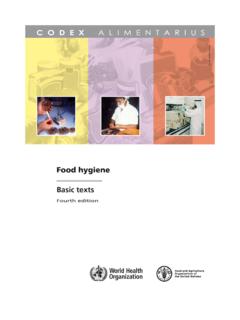Transcription of NJDEP-N.J.A.C. 7:9C-Ground Water Quality Standards
1 THIS IS A COURTESY COPY OF THIS RULE. SHOULD THERE BE ANY DISCREPANCIES BETWEEN THIS TEXT AND THE OFFICIAL VERSION OF THE PROPOSAL, THE OFFICIAL VERSION WILL GOVERN. This is a courtesy copy of this rule. All of the Department's rules are compiled in Title 7 of the New Jersey Administrative Code. 7:9C Ground Water Quality Standards Statutory Authority: 58:10A-1 et seq. and 58:11A-1 et seq. Date Last Amended: August 9, 2018 (see 50 1963(a)). For regulatory history and effective dates, see the New Jersey Administrative Code. Table of Contents 7 Scope 7 Policies 7 Construction 7 Definitions 7 Ground Water classification system and designated uses 7 Exceptions to the classification system 7 Ground Water Quality criteria 7 Antidegradation policy 7 Constituent standard modifications and practical quantitation levels 7 Procedures for reclassification of ground Water 7 Severability Appendix Table 1 Specific Ground Water Quality criteria : Class II-A Appendix Table 2 Interim Generic Ground Water Quality criteria Figure 1: New Jersey Ground Water Classification System Class I-PL New Jersey Pinelands Figure 2: New Jersey Ground Water Classification System Class III-A Aquitards of the New Jersey Coastal Plain Figure 3: New Jersey Ground Water Classification System Class III-B Cretaceous Potomoc-Raritan-Magothy Formation Figure 4: New Jersey Ground Water Classification System Class III-B Farrington Aquifer Figure 5.
2 New Jersey Ground Water Classification System Class III-B Old Bridge Aquifer CHAPTER 9C GROUND Water Quality Standards 2 SUBCHAPTER 1. GROUND Water Quality Standards 7 Scope of chapter (a) Unless otherwise provided by statute, this chapter constitutes the rules of the Department of Environmental Protection concerning ground Water classification, designated uses of ground Water , and ground Water Quality criteria and constituent Standards , pursuant to the Water Pollution Control Act ( 58:10A-1 et seq.) and the Water Quality Planning Act ( 58:11A-1 et seq.). (b) This chapter provides the basis for protection of ambient ground Water Quality , through the establishment of constituent Standards for ground Water pollutants. These constituent Standards are applicable to the development of: ground Water protection Standards pursuant to the New Jersey Pollutant Discharge Elimination System (NJPDES; 7:14A); ground Water remediation Standards ; and other requirements and regulatory actions applicable to discharges that cause or may cause pollutants to enter the ground waters of the State, including non-point and diffuse sources regulated by the Department.
3 Other relevant laws through which the Ground Water Quality Standards may be applied include, but are not limited to, the Spill Compensation and Control Act ( 58 et seq.), the Brownfield and Contaminated Site Remediation Act ( 58:10B-1 et seq.), the Site Remediation Reform Act ( 58:10C-1 et seq.), the Solid Waste Management Act ( 13:1E-1 et seq.), the Industrial Site Recovery Act ( 13:1K-6 et seq.), the Underground Storage of Hazardous Substances Act ( 58:10A-21 et seq.), the Realty Improvement Sewerage and Facilities Act ( 58:11-23 et seq.), and the Pesticide Control Act of 1971 ( 13:1F-1 et seq.). (c) This chapter constitutes the Department's primary basis for setting numerical criteria for limits on discharges to ground Water and Standards for ground Water remediation. 7 Policies (a) It is the policy of this State to restore, enhance and maintain the chemical, physical, and biological integrity of its waters, to protect public health, to safeguard fish and aquatic life and scenic and ecological values, and to enhance the domestic, municipal, recreational, industrial and other uses of Water .
4 (b) Discharges to ground Water that subsequently discharges into surface waters shall not be permitted by the applicable regulatory program if such discharges would cause a contravention of surface Water Quality Standards applicable to those surface waters. That is, those discharges must achieve compliance with both these Standards and the surface Water Quality Standards ( 7:9B). (c) When existing ground Water Quality does not meet the constituent Standards determined pursuant to 7 , and , due to human activities, the Department shall, after a review of relevant and available scientific and technical data, determine in the context 3 of the applicable regulatory programs the management actions necessary (including, but not limited to, the requirement of remedial actions) to restore or enhance ground Water Quality pursuant to the policies of this chapter.
5 (d) The Department shall not approve discharges or activities posing a significant risk of discharges, within the jurisdiction of and subject to regulation by the Pinelands Commission, that would contravene the rules of the Pinelands Commission with regard to the protection of ground Water or surface Water Quality . 7 Construction This chapter shall be liberally construed to permit the Department to implement its statutory functions. 7 Definitions The following words and terms, when used in this subchapter, shall have the following meanings: ACL means alternative concentration limit. "Agricultural Water " means Water used for crop production, livestock, horticulture and silviculture. "Alternative concentration limit" or ACL means a constituent standard or narrative description of actions, discharge controls and Water Quality requirements that is less stringent than the ground Water Quality requirements of 7 , and , due to a Departmental determination pursuant to NJPDES regulations ( 7 (b)).
6 In order to approve an ACL, the Department must find that the relevant constituent standard(s) cannot be achieved through technologically practicable means. "Applicable regulatory program" means any of the Department's programs which implement the regulations issued pursuant to the statutes cited in 7 (b) or in any other regulations that specifically cite this chapter. "Aquifer" means a saturated geologic formation(s) or unit(s) which is sufficiently permeable to transmit Water to a pumping well in usable and economic quantities. The upper level of an unconfined aquifer may vary over time; "aquifer" applies to the full saturated zone at any time. "Aquitard" means a hydrogeologic confining unit(s) that exhibits limited permeability, bounding one or more aquifers, that does not readily yield Water to wells or springs, but may serve as a storage unit for ground Water and may release this Water to adjacent ground Water units or surface waters.
7 Such confining units are further defined and listed in 7 (f)1 or may be established through reclassification under 7 4 "Background Water Quality " means the concentration of constituents in ground Water which is determined to exist directly upgradient of a discharge but not influenced by the discharge, or is otherwise representative of such concentration of constituents as determined using methods and analyses consistent with the requirements of 7 (g). Carcinogen means a constituent capable of inducing a cancer response, including Group A (Human Carcinogen), Group B (Probable Human Carcinogen) or Group C (Possible Human Carcinogen) categorized in accordance with the USEPA Guidelines for Carcinogen Risk Assessment, 51 Fed. Reg. 33992, 1986, incorporated herein by reference, as amended or supplemented. "Classification area" means the geographic extent (lateral and vertical) of a geologic formation(s) or unit(s) wherein ground Water is classified for designated uses, as described in 7 "Classification exception area" means an area within which one or more constituent Standards and designated uses are suspended in accordance with 7 Conservation restriction means the restricting of development on property as that term is defined under the New Jersey Conservation Restriction and Historic Preservation Restriction Act, 13:8B-1 et seq.
8 "Constituent" means a specific chemical substance (that is, element or compound) or Water Quality parameter (for example, temperature, odor, color). "Constituent standard" means the required maximum level or concentration or the required range of levels or concentrations (as applicable) for a constituent in a classification area, as established in 7 , and (a) and (b). The constituent Standards shall be the basis for the Department's regulation of ground Water Quality effects of past, present or future discharges to ground Water or the land surface, pursuant to applicable authorities as defined in 7 "Conventional Water supply treatment" means the chemical and physical treatment of ground Water supplies for microbiological contaminants and undesirable naturally occurring substances resulting in treated Water that meets all the primary and secondary Standards for those constituents stipulated by the New Jersey Safe Drinking Water Act regulations ( 7 et seq.)
9 " criteria " means ground Water Quality criteria . "Department" means the New Jersey Department of Environmental Protection. "Designated use" means a present or potential use of ground Water which is to be maintained, restored and enhanced within a ground Water classification area, as determined by 7 Designated uses may include any human withdrawal of ground Water (for example, for potable, agricultural and industrial Water ), the discharge of ground Water to surface 5 waters of the State which support human use or ecological systems, or the direct support of ecological systems. "Discharge" means an intentional or unintentional action or omission resulting in the releasing, spilling, leaking, pumping, pouring, emitting, emptying or dumping of a pollutant at any time into the waters of the State, onto land or into wells from which it might flow or drain into said waters, or into waters or onto lands outside the jurisdiction of the State, which pollutant enters the waters of the State.
10 "Discharge" includes, without limitation, the release of any pollutant into a municipal treatment works. "Discharger" means any person, corporation, municipality, government agency or authority or other legal entity, who causes or allows a discharge, either through action or omission. "Extensive exceedance", as used in 7 , means a condition where ground Water Quality in an area exceeds the criteria of 7 for one or more constituents over the vast majority of the subject area for such constituent(s) and that such exceedances are not attributable to the past or present discharges of a single discharger or any group of active NJPDES permitted discharges. "FW1" means those surface fresh waters defined as such in the Surface Water Quality Standards , 7:9B and shown on maps maintained by the Department. "Ground Water " means the portion of Water beneath the land surface that is within the saturated zone.
